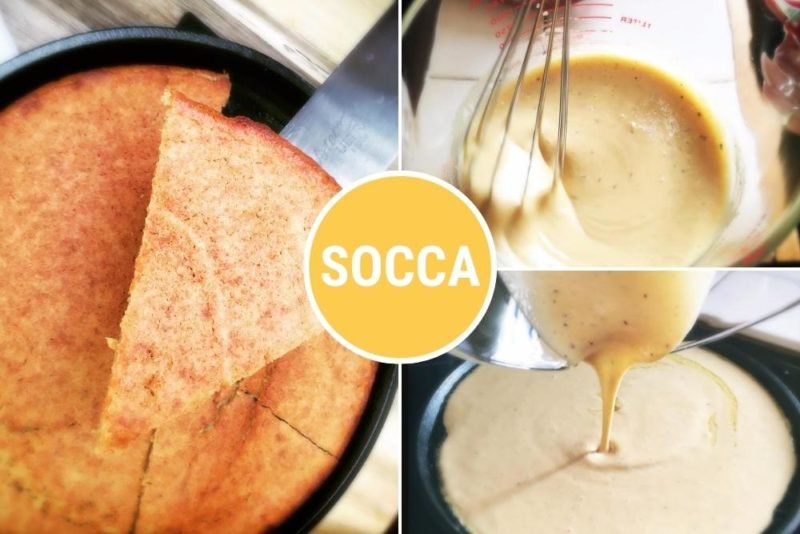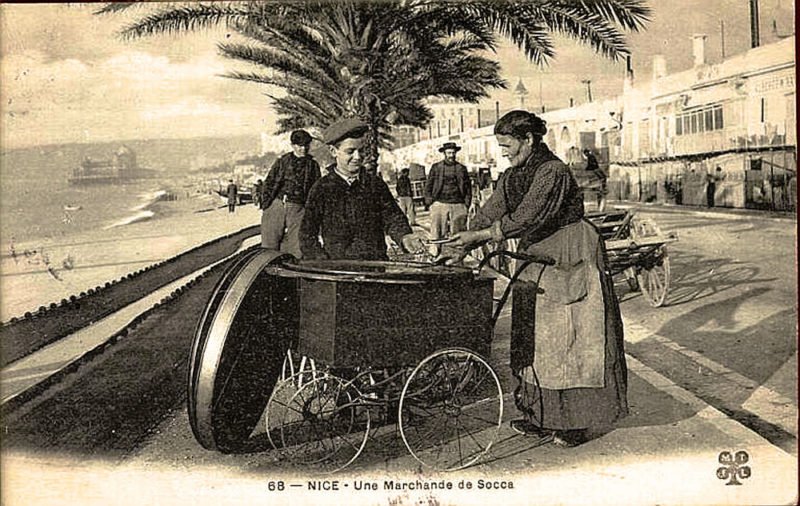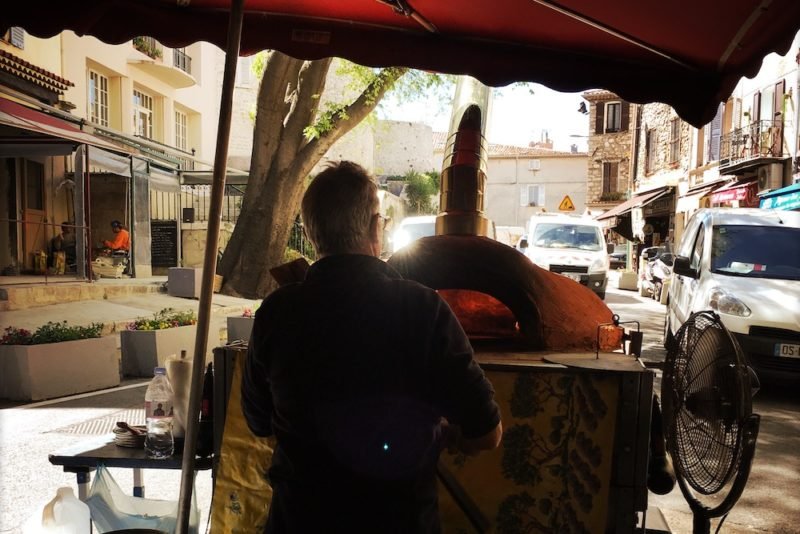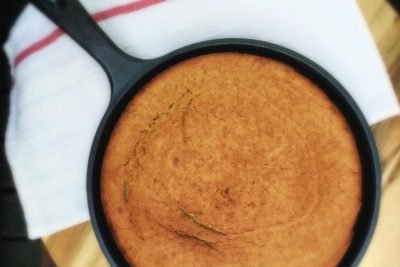
I haven’t traveled abroad since the spring of 2018, when we went to Amsterdam and Paris. We had planned a bye year for 2019, because we had just moved and were building a house. Little did we know that traveling would be out for 2020 and 2021, too! (We still have high hopes for 2022, but at this point we think we’re canceling our tentatively planned April trip to South Africa and Paris. Maybe Buenos Aires in November?)
Part of what keeps past travels alive in my mind is food. Specifically memorable snacks or meals, especially those that we have been able to more-or-less recreate at home. One of these is socca, a large, thin pancake of chickpea flour (aka garbanzo bean flour), water, olive oil, and salt and pepper. Socca started to become popular in the early 1900s, sold from portable ovens as a nourishing, inexpensive snack for fisherman and laborers in Nice, as depicted in this postcard from around that time (courtesy of Wikipedia Commons):

I’d known about socca for ages before we first ventured to the south of France in the spring of 2016, but my interest in it certainly peaked as I planned where we might go and what we might see. I thought our first taste of socca would be in Nice, but instead it was in Antibes. We had chanced upon a socca-maker (baker?), and his wood-fired oven on wheels, at the weekly covered farmer’s market (photo below). He swiftly removed the socca from the oven, sliced it into segments, salted and peppered it, then portioned it onto waxed paper for blissful consumption on the spot.
Our second sampling was by chance, when we went into the little town of Vence, which we were renting an apartment outside of. The farmers market was shutting down for the day, but the socca cart was still going strong for a few more rounds. The only thing missing (in both cases, sadly) was a cool glass of rosé. Vive la France!

Getting your socca on at home
Chickpea flour can be used in so many ways (as the cookbook Chickpea Flour Does it All neatly sums it up) but socca is definitely my favorite ways to use it. Socca is popular not just in southern France, but also in Italy (where it’s called farinata).
The traditional—and best—way to cook it is in a wood-fired oven (mobile or otherwise), but you can easily make do with your home oven using a skillet or pizza pan (I use a 10.5-inch round Lodge cast-iron griddle). Having experienced both, I wouldn’t say that the homemade version is exactly the same, but it is quite delicious!
You can usually find chickpea (garbanzo bean) flour at higher-end and/or natural food markets, such as Whole Foods or, for my Seattle readers, PCC Community Markets or Metropolitan market. I’ll admit that I sometimes have a hard time finding straight, as some stores opt to stock chickpea/fava bean flour, but that works, too. I usually end up ordering chickpea flour from Bob’s Red Mill, when I have enough other stuff I need from them to qualify for free shipping (something I’ve been doing more since the pandemic began). You can also find it easily on Amazon.

Socca
Ingredients
- 1 cup chickpea flour
- 3/4 teaspoon sea salt
- 1/2 teaspoon freshly ground pepper
- 1/8 teaspoon cumin (you can substitute a tablespoon of finely chopped rosemary, thyme or oregano, or use no spices or herbs at all)
- 1 cup water
- 2 tablespoons extra virgin olive oil + more for the pan
Instructions
- Combine dry ingredients in a mixing bowl and whisk to combine. Slowly add the water, whisking to break up any lumps. Add the 2 tablespoons olive oil and briefly whisk again. Cover and allow to sit undisturbed for at least 1 hour but up to 12 hours.
- Place one oven rack in the middle and another about 6 inches from the top. Place a cast-iron or other heavy 10- to 12-inch skillet or pizza pan in the oven and preheat to 450 degrees.
- Carefully remove the hot pan and add 1 tablespoon of oil, swirling to coat the bottom of the pan. Whisk the chickpea batter briefly, then pour it into the pan and put back in the oven. Bake for 8-10 minutes, or until it looks firm and the edges are set.
- Heat the broiler and brush the top of the socca with more olive oil, if desired. Set the pan on top rack and broil until the socca is browned in spots.
- Use a spatula to remove the socca from the pan, cut into wedges, and serve hot!
Notes
This post contains Amazon Affiliate links. As an Amazon Associate I earn from qualifying purchases.
Carrie Dennett, MPH, RDN, is a Pacific Northwest-based registered dietitian nutritionist, journalist, intuitive eating counselor, author, and speaker. Her superpowers include busting nutrition myths and empowering women to feel better in their bodies and make food choices that support pleasure, nutrition and health. This post is for informational purposes only and does not constitute individualized nutrition or medical advice.
Seeking 1-on-1 nutrition counseling? Learn more about her Food & Body, IBS management, and nutrition counseling programs, and book an intro call to see if the program is a good fit, and if we’re a good fit!
Want exclusive content on nutrition, health, diet culture and more, plus critiques of nutrition and health journalism? Subscribe to my Food Noise newsletter! 📣
 Print This Post
Print This Post









